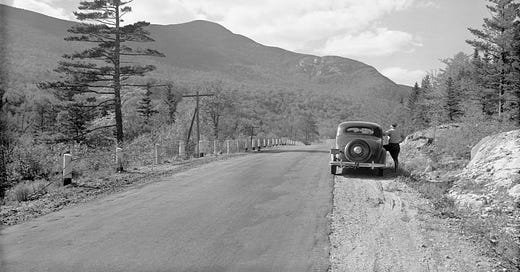Goose Eye No. 3 (2023)
From Hardscrabble Village to Hiking Mecca
The Story of Grafton, Maine
William F. Chapman
After several hours of difficult bushwhacking, Moses B. Sears arrived at the top of the mountain we know today as Old Speck. As he looked out and surveyed the valley below, he was overcome by emotion. “[I] felt that [I was] not on the earth,” he wrote, “but [was] exalted to the ethereal regions.”
That God had created this mountain, rounded it in the palm of his hand, and planted it here to show forth his creative power and glory—that [I] stood not in a temple made by man’s puny hands, but in Nature’s high temple where, with his judges, he had traced in legible characters his own omnipotence, and that here alone might man commune and hold sacrament.1
Though many have doubtless had similarly spiritual experiences upon summiting Oxford County’s highest peak, few have had to work quite so hard for the payoff. There were no blazed trails in 1850 when Sears made his ascent up Speckled Mountain—as it was then called—no lean-to shelters, and no smart phone apps or even guidebooks to follow. Just reaching the base of the mountain was itself a challenge, and there were few options for accommodations, although in those days one could nearly always rely on the hospitality of a local family.
Sears was a trailblazer in every sense. In 1833, when he was 27, he had been among the founding members of the Maine Anti-Slavery Society at a time when abolitionist activity, even in the North, was viewed with contempt or suspicion, and frequently brought intense reaction.2 The Winthrop man was one of several brilliant and forward-thinking individuals associated with the mid-nineteenth century farmers movement.
His friend Ezekiel Holmes started the Maine Farmer and Journal of the Useful Arts in Winthrop in 1833. The paper sought to inform and give voice to independent farmers—and also, for a time, craftsmen and laborers—to uplift and educate them, and to advocate for their interest. It was part of a wave of similar newspapers founded in the 1830s and 1840s and aimed at ordinary workingmen. This was spurred by increasing rates of literacy and the growing importance of non-elites as a political constituency as all across the country property requirements were dropped for voting and suffrage became nearly universal among white males. These changes are linked with the Jacksonian era, although certainly not all newspapers of this type supported (and many were founded in direct opposition to) Andrew Jackson’s presidency.3
An intellectual haven for rural autodidacts, the Farmer was a place where one could read about the meetings of groups such as the Anti-Slavery Society, sandwiched in between articles on such topics as the latest science in crop rotation or advice on the pruning and care of fruit trees. The paper was born of the same spirit that would soon give rise to the organization of numerous farmer’s clubs—with the Bethel Farmers Club, founded by Nathaniel Tuckerman True in 1853, leading the way in Maine—the National Grange, and, eventually, the Greenback and Populist movements and their associated political parties. This work was slow at first. Dr. True, who would later assume editorship of the Maine Farmer, testified that, “not more than four or five persons could be induced to join” the Bethel Farmers Club on its first founding, and that “even these were exposed to the ridicule of their neighbors, but they persevered.”4
It was for the purpose of reporting back to the Maine Farmer that Sears made his tour through western Maine in 1850. His ascent of Speck, while perhaps not the first in history, is almost certainly the earliest to be the subject of a full written account.
Two years later, a party from New York visited the region for sightseeing and made what is likely the first documented ascent of Bear River White Cap or Baldpate.5 These early accounts show the pull that the mountains had on people from all over New England and beyond, even during the early period of settlement, at a time when getting there required a journey of several days and multiple forms of transportation.
Today tens of thousands of people visit Grafton Notch State Park every year. Perhaps a thousand pass through on their way to completing a hike of the entire 2,200 miles of the Appalachian National Scenic Trail.6 Yet few of these outdoor enthusiasts likely realize that the valley was once home to a small community of tough-minded pioneers.
Rocky Start
The rugged terrain that makes Grafton so attractive to adventurers, yet proved so resistant to permanent settlement, began to form hundreds of millions of years ago, when the supercontinent of Gondwana collided with the mass of land that would eventually become North America.




